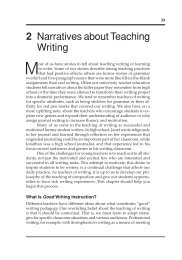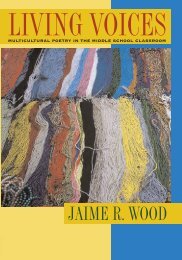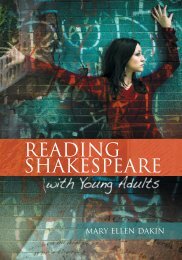Graphic novel Spread - National Council of Teachers of English
Graphic novel Spread - National Council of Teachers of English
Graphic novel Spread - National Council of Teachers of English
- No tags were found...
Create successful ePaper yourself
Turn your PDF publications into a flip-book with our unique Google optimized e-Paper software.
10 James Bucky Carter<br />
assisting high school students to read” More recently (November 2004,<br />
pp. 114–18), editor Don Gallo asked librarian Stephen Weiner to formally<br />
introduce graphic <strong>novel</strong>s to <strong>English</strong> Journal’s readers in the Bold Books<br />
for Innovating Teaching section, and The <strong>Council</strong> Chronicle for September<br />
2005 features two articles on graphic <strong>novel</strong>s and comics. NEAToday<br />
even got in on the action in February 2005, with Thomas Grillo’s article<br />
“Back to the Future: How <strong>Teachers</strong> Are Using Old Favorites to Hook<br />
the Newest Generations <strong>of</strong> Reluctant Adolescent Readers.” What’s the<br />
hook Comic books, <strong>of</strong> course.<br />
The hook <strong>of</strong> comics can be especially strong for boys. In their longitudinal<br />
study <strong>of</strong> male reading habits (Reading Don’t Fix No Chevys,<br />
2002), Michael W. Smith and Jeffrey D. Wilhelm found that graphic <strong>novel</strong>s<br />
are one <strong>of</strong> the few types <strong>of</strong> texts that consistently engage male readers.<br />
Edgy, engaging, and different (pp. 148–57), graphic <strong>novel</strong>s satisfied<br />
boys’ overwhelmingly clear urge to explore visual texts. The authors<br />
state, “The intense importance <strong>of</strong> the visual as they engaged with all<br />
forms <strong>of</strong> texts was evident” and “ a few engaged readers in this study<br />
all described their reading <strong>of</strong> books and stories in strikingly visual<br />
terms” (pp. 151–52). Important to our work in this collection <strong>of</strong> essays<br />
is their assertion that “A challenge here is for teachers to develop ways<br />
to assist boys who do not visualize what they read to develop ways <strong>of</strong><br />
doing so. Otherwise they will not experience the same engagement with<br />
written texts that they do with multimedia ones” (p. 152). <strong>Graphic</strong> <strong>novel</strong>s<br />
and comics, mostly produced for and consumed by males, give knowledgeable<br />
teachers a means to help show boys that, not only successful<br />
readers, but also successful writers and artists visualize as they work.<br />
(For other books with testimonials about comics from students and<br />
teachers, try Krashen’s The Power <strong>of</strong> Reading [2002] and Shelley Hong<br />
Xu’s Trading Cards to Comic Strips [2005].)<br />
Among recent graphic <strong>novel</strong> proponents, Michele Gorman, a librarian<br />
from Austin, Texas, has done much for the format’s new positioning<br />
in education via her book Getting <strong>Graphic</strong>: Using <strong>Graphic</strong> Novels<br />
to Promote Literacy with Preteens and Teens (2003). She asserts, “Research<br />
done by pr<strong>of</strong>essionals in the field and real-life experience <strong>of</strong> librarians<br />
have shown that there is one format that covers a variety <strong>of</strong> genres, addresses<br />
current and relative issues for teens, stimulates the young<br />
people’s imagination, and engages reluctant readers: graphic <strong>novel</strong>s”<br />
(2003, p. xi). Gorman joins a rather extensive list <strong>of</strong> librarians who have<br />
been carrying the torch for graphic <strong>novel</strong>s as aids to literacy (DeCandido,<br />
1990; Bruggeman, 1997; Lavin, 1998; Weiner, 2002; Goldsmith, 2003) in<br />
their own pr<strong>of</strong>essional journals and conferences. Indeed, the American
















